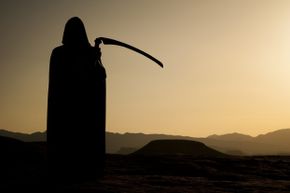With respect to sages and crystal ball advocates around the world, you never know how or when you're going to go. There are a lot of ways to die, and some are certainly more bizarre than others. Even natural causes like heart failure can be brought on by some pretty strange circumstances. So while a death certificate may read, "died while sleeping," the fine print might say, "after a satellite fell through the roof."
Throughout history there have been some pretty unusual deaths. Attila the Hun is said to have died from a nosebleed. Isadora Duncan, a popular American dancer in the 1920s, was strangled to death after her scarf got caught up in the axle of the car she was riding in. Stanford White, architect of New York's Madison Square Garden, was shot and killed on the roof of the building he designed. And writer Tennessee Williams famously choked on a bottle cap.
Advertisement
Those are odd and ironic ways to go, but they don't hold a candle to the 10 bizarre deaths on the following pages.









